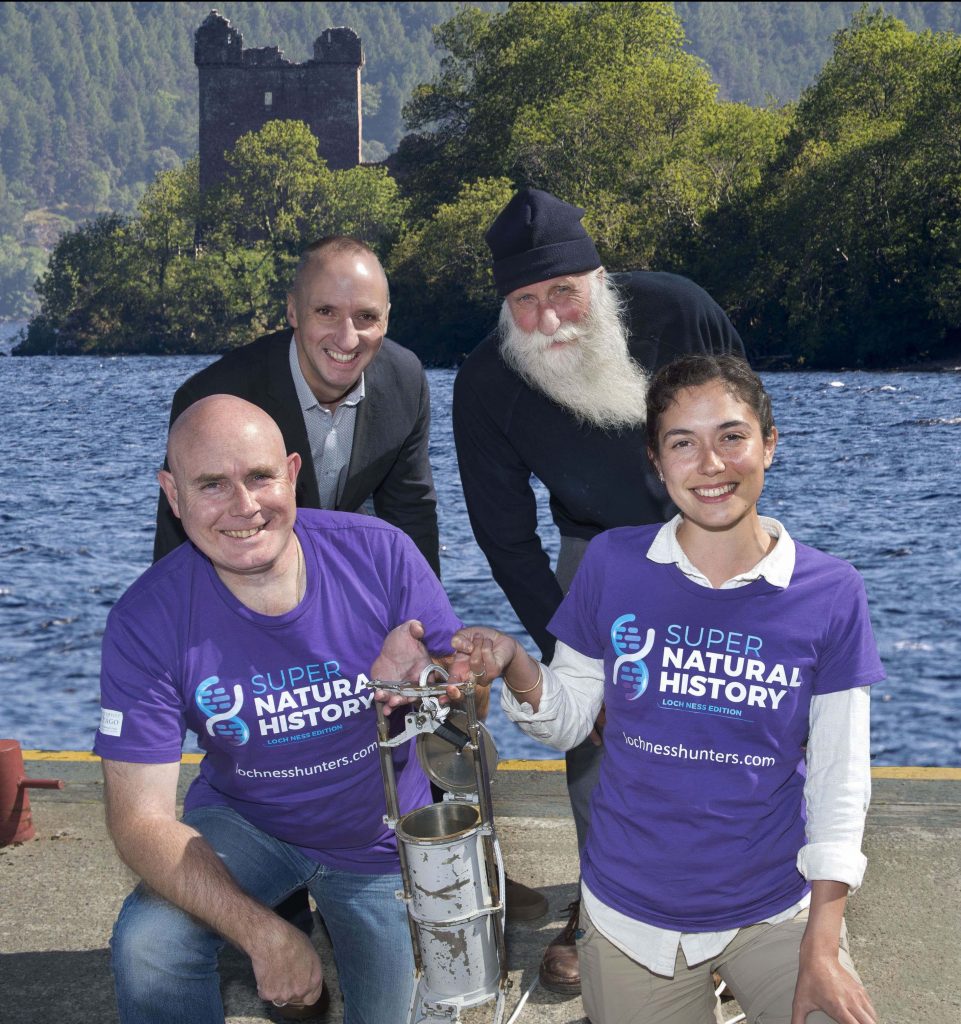A new team of scientists have started a search of the murky depths of Loch Ness to investigate the mystery of Nessie. Only this time they are looking at the DNA in the Loch. The group is led by Professor Neil Gemmell of the University of Otago, New Zealand.

Front taking samples of Loch Ness
Prof Neil J Gemmell and
Christina Lynggaard from the Dept of Anatomy and Biomedical Sciences Otago University New Zealand
Back Chris Taylor VisitScotland
Adrian Shine Loch Ness Expert
Pic Trevor Martin
This examination will involve sampling the water and looking at the concentration of living things, looking at what lurks inside that water and then the extracting of DNA from the loch.
Scientists say that as the creatures move through the loch, they leave tiny fragments of DNA through their skin, scales, feathers, fur, faeces and urine.
They will be travelling the length of the loch on the Loch Ness Project’s research vessel, Deepscan, taking water samples from three different depths. These samples will then be sent to labs in New Zealand, Australia, Denmark and France to be analysed for the final findings of research which will be released in early 2019.
Professor Neil Gemmell is not trying to prove or disprove the existence of Nessie but to see if there is any unusual DNA down there, he says “Scotland is dear to my heart because my mother and her family are Scottish, I’m delighted to be here to undertake our environmental DNA investigation of Loch Ness. It’s a place of extraordinary natural beauty.”
“We’re delighted with the amount of interest the project has generated in the science and, monster or not, we are going to understand Loch Ness, and the life in it, in a new way.”
Investigations are also being carried out at nearby Lochs such as Morar, Oich and Garry as control groups that could potentially reveal if there is something unusual lurking in Loch Ness.
Hundreds of thousands of visitors travel to Loch Ness and nearby Drumnadrochit every year to try and catch a glimpse of the mythical monster.
Chris Taylor, VisitScotland regional leaderships director, said: “The mystery and the intrigue of the Loch Ness Monster attract visitors from all over the world to the stunning area every year.
“It is exciting to welcome Professor Gemmell and his team to the Loch and we will be eagerly anticipating their findings.
“While the research could provide an insight into one of the world’s most famous enigmas, it will certainly offer a closer look at all of the different creatures living in the Loch.”
“Tourism is the heartbeat of the Scottish economy, creating jobs and sustaining communities, so it is great to have a spotlight on Loch Ness and encourage more visitors to discover what lies beneath its depths and beyond its banks.”
The earliest report of a monster in Loch Ness appears in the ‘Life of Saint Columba’ 565 by Adomnan, written in the sixth century AD. According to Adomnán, writing about a century after the events described, Irish monk Saint Columba was staying in the land of the Picts with his companions when he encountered local residents burying a man by the River Ness. They explained that the man was swimming in the river when he was attacked by a “water beast” which mauled him and dragged him underwater. Although they tried to rescue him in a boat, he was dead. Columba sent a follower, Luigne moccu Min, to swim across the river. The beast approached him, but Columba made the sign of the Cross and said: “Go no further. Do not touch the man. Go back at once.” The creature stopped as if it had been “pulled back with ropes” and fled, and Columba’s men and the Picts gave thanks for what they perceived as a miracle.
There have been many reports through the centuries. In 1933 there was a sighting, telling of a 10ft long limbless creature crossing the road leaving behind a slimy trail of undergrowth. I’m thinking there might have been a pub nearby.
In 1975 four firemen from Hemel Hempstead decided that the monster must be a male, as all monsters usually are, so they built a 309 foot long papier-mâché ‘lady monster’ to attract ‘Mr Nessie’. It had false eyelashes, full make-up and gave out a pre-recorded mating call. Unfortunately the mating call turned out to be that of a male walrus, so not unsurprisingly it didn’t tempt Nessie! It didn’t help either when the lady monster got damaged when set afloat on the water. Her ‘behind’ was flattened by the jetty when a sudden wind blew her sideways. The attempt was abandoned.
In 2001 a pair of fishermen spotted a dark 6ft long blob sticking its head out of the water and were adamant that it was not a seal.
It seems that 2017 was a record year for sighting this century.
Loch Ness and its surrounding areas are stunning places to go to, but you have to admit that this little mystery makes it even more so. I think that even if absolutely nothing unusual is found people will still believe that Nessie is alive and well somewhere in Loch Ness.
